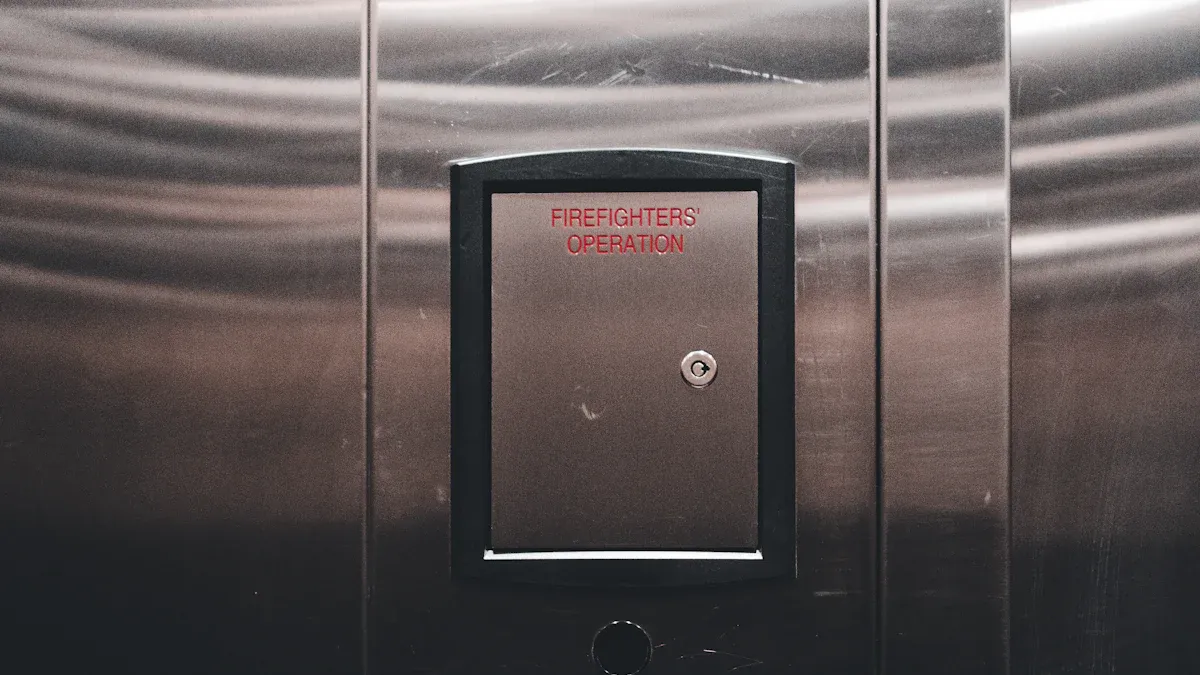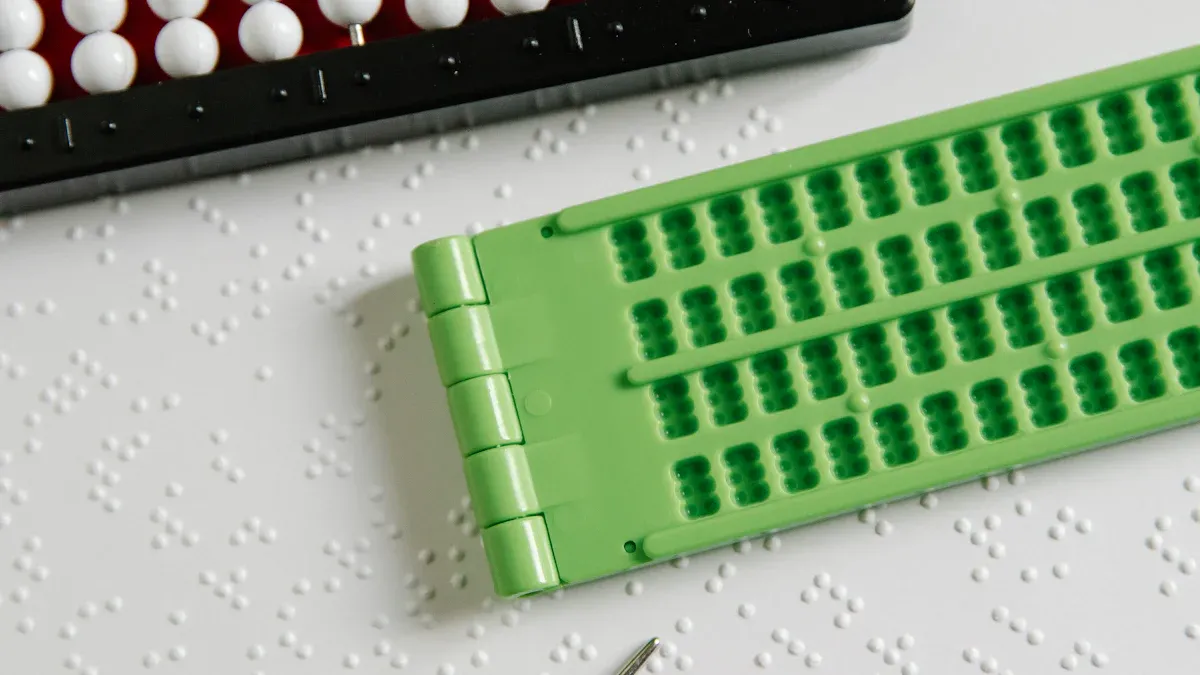
You want every Numeric Industrial Braille Keypad to work smoothly and safely. Start with the right tools and follow each step carefully. Pay attention to safety as you handle equipment. Make sure you install the keypad so everyone can use it. A secure and accessible keypad helps everyone.
Key Takeaways
- Gather all necessary tools and materials before starting to ensure a smooth installation process.
- Choose an accessible location that meets height and safety guidelines to make the keypad easy for everyone to use.
- Follow safety steps carefully during wiring and test the keypad fully to ensure it works correctly and lasts longer.
Numeric Industrial Braille Keypad: Tools and Materials

Essential Tools
You need the right tools to install a Numeric Industrial Braille Keypad. Gather these before you start:
- Screwdriver set (Phillips and flathead)
- Power drill with drill bits
- Wire stripper and cutter
- Voltage tester
- Level
- Measuring tape
Tip: Use a cordless drill for faster work and easier handling.
Required Materials
You must have all the necessary materials ready. This helps you avoid delays during installation. Here is a table to help you organize:
| Material | Purpose |
|---|---|
| Numeric Industrial Braille Keypad | Main device for installation |
| Mounting screws | Secure the keypad to the surface |
| Wall anchors | Support keypad on drywall or masonry |
| Electrical wires | Connect keypad to power source |
| Wire connectors | Ensure safe electrical connections |
| Back box (if needed) | House wiring behind the keypad |
Optional Accessories
Some accessories can make your installation easier or improve the keypad’s function. You may want to consider:
- Weatherproof cover for outdoor use
- Tamper-resistant screws for extra security
- Cable management clips
- Label stickers for wiring identification
- Protective gloves for safety
Note: Optional accessories are not always required, but they can help you achieve a more professional result.
Numeric Industrial Braille Keypad: Pre-Installation Preparation
Selecting the Installation Location
You need to choose the right spot for your keypad. Pick a place that everyone can reach easily, including people who use wheelchairs. Make sure the area has enough light. Avoid spots near water or where the keypad could get wet. If you install the keypad outdoors, look for a place with some cover. Use a measuring tape to check the height. Most guidelines suggest placing the keypad between 34 and 48 inches from the floor.
Tip: Ask users for feedback about the location before you start drilling holes.
Checking System Compatibility
Check if your Numeric Industrial Braille Keypad works with your current system. Look at the keypad’s manual and your building’s wiring diagram. Make sure the voltage and wiring match. If you connect the keypad to a security system, check the input and output types. Some keypads need special connectors or adapters. If you feel unsure, contact the manufacturer or a licensed electrician.
Preparing the Mounting Surface
Clean the wall or surface where you plan to mount the keypad. Remove dust, dirt, or grease. Use a level to mark straight lines for drilling. If you mount the keypad on drywall, use wall anchors for extra support. For concrete or brick, use a masonry bit and the right anchors. Double-check your marks before you drill.
Numeric Industrial Braille Keypad: Installation Steps

Mounting the Keypad
Start by holding the Numeric Industrial Braille Keypad against the wall or mounting surface. Use a pencil to mark the screw holes. Make sure the keypad sits level. You can use a bubble level to check this. If you need to drill into drywall, use wall anchors to keep the screws secure. For brick or concrete, use a masonry bit and the right anchors.
Follow these steps to mount the keypad:
- Mark the screw holes using the keypad as a template.
- Drill pilot holes at the marked spots.
- Insert wall anchors if needed.
- Place the keypad over the holes.
- Insert and tighten the mounting screws.
Tip: Do not overtighten the screws. You want the keypad to stay secure, but too much force can crack the housing.
Wiring and Electrical Connections
Before you start wiring, turn off the power at the circuit breaker. This step keeps you safe from electric shock. Use a voltage tester to make sure the wires are not live.
Connect the keypad wires to the building’s electrical system. Most Numeric Industrial Braille Keypads have color-coded wires. Check the manual for the correct wiring diagram. Use wire strippers to remove a small section of insulation from each wire. Twist the wires together with wire connectors.
Here is a simple wiring checklist:
| Step | Action |
|---|---|
| 1. Power Off | Turn off power at the breaker |
| 2. Strip Wires | Remove insulation from wire ends |
| 3. Match Wires | Connect keypad wires to building wires |
| 4. Secure Connectors | Twist on wire connectors |
| 5. Double-Check | Tug wires gently to check connections |
Always follow the wiring diagram in your keypad’s manual. If you feel unsure, ask a licensed electrician for help.
Securing the Keypad
After you finish wiring, push the wires gently into the wall or back box. Make sure nothing pinches or bends. Place the Numeric Industrial Braille Keypad back onto its mounting plate. Insert the screws and tighten them until the keypad feels firm.
Check that the keypad does not move when you press the buttons. If you install the keypad outdoors, add a weatherproof cover. This cover protects the keypad from rain and dust.
- Test the keypad by pressing each button.
- Make sure the keypad sits flat against the wall.
- Clean up any dust or debris from the installation area.
A secure keypad lasts longer and works better. Take a few minutes to check your work before moving on.
Numeric Industrial Braille Keypad: Accessibility and Compliance
Verifying Braille Accuracy
You need to check the Braille on your keypad before you finish the installation. Each button should have clear and correct Braille dots. Use your fingers to feel each symbol. If you know Braille, read each number to make sure it matches the printed label. You can also ask a Braille reader to help. If you find any mistakes, contact the manufacturer for a replacement.
Tip: Use a Braille translation chart to double-check each symbol.
Testing Tactile Feedback
Tactile feedback helps users know when they press a button. Press each key on the Numeric Industrial Braille Keypad. You should feel a gentle click or bump. This feedback tells users the button works. If a button feels stuck or too loose, fix it before you finish. Good tactile feedback makes the keypad easier for everyone to use.
Here is a simple checklist:
- Press every button.
- Feel for a click or bump.
- Check for stuck or loose keys.
Ensuring Accessibility Standards
You must follow accessibility rules when you install the keypad. Place the keypad at a height that people in wheelchairs can reach. Make sure there is enough space around the keypad for easy access. The Braille should be easy to read, and the buttons should not be too small. Check local and national guidelines for public spaces.
Note: Meeting these standards helps everyone use the keypad safely and easily.
Numeric Industrial Braille Keypad: Testing and Troubleshooting
Functional Testing
After you finish installing the Numeric Industrial Braille Keypad, you need to test it. Start by turning the power back on. Press each button and listen for a beep or click. Watch for any lights that show the keypad is working. Try entering a code or using the keypad as you would in daily use. If the keypad connects to a door or gate, check that it unlocks or opens as expected.
Tip: Test the keypad with different users to make sure everyone can use it easily.
Addressing Common Issues
Sometimes, you may find problems after installation. Here are some common issues and what you can do:
- No power: Check the wiring and make sure the power is on.
- Buttons do not respond: Look for loose wires or poor connections.
- Incorrect code entry: Double-check the wiring and the keypad’s settings.
- Weak tactile feedback: Make sure the keypad is not mounted too tightly.
Use this table to help you spot and fix issues:
| Problem | Possible Cause | Solution |
|---|---|---|
| No lights or sound | Power issue | Check wiring and breaker |
| Some keys not working | Loose connection | Reconnect wires |
| Hard to press buttons | Mounting too tight | Loosen screws slightly |
Troubleshooting Procedures
If you still have trouble, follow these steps:
- Turn off the power before checking wires.
- Remove the keypad and inspect all connections.
- Use a voltage tester to check for power.
- Reinstall the keypad and test again.
If you cannot solve the problem, contact the manufacturer or a licensed electrician for help.
Numeric Industrial Braille Keypad: Maintenance Tips
Cleaning and Care
You should keep your Numeric Industrial Braille Keypad clean to help it last longer. Use a soft, damp cloth to wipe the surface. Avoid harsh chemicals or too much water. Dirt and dust can build up around the buttons. You can use a small brush or compressed air to clean between the keys. Always turn off the power before cleaning. This keeps you safe and protects the keypad.
Tip: Clean your keypad once a week if you use it often.
Inspecting for Wear
Check your keypad for signs of wear. Look at the buttons and Braille dots. If you see faded numbers or worn Braille, users may have trouble. Press each button to make sure it works. If a button feels loose or sticks, you may need to fix it. Look for cracks or damage on the keypad housing.
Here is a quick inspection checklist:
- Check for faded labels or Braille
- Test each button for smooth movement
- Look for cracks or broken parts
Preventive Maintenance
You can prevent problems by doing regular maintenance. Tighten any loose screws. Make sure the keypad stays secure on the wall. Test the keypad’s function every month. If you find any problems, fix them right away. Keep a record of your maintenance checks. This helps you spot patterns and plan repairs.
Regular care keeps your keypad safe and easy to use for everyone.
You can install a keypad by following each step in this guide. Check your work for safety and accessibility. Keep the keypad clean and test it often. When you follow these tips, you help everyone use the keypad easily and safely. Use this guide for every installation.
FAQ
How often should you clean your Braille keypad?
You should clean your keypad once a week. Use a soft, damp cloth. This keeps the buttons and Braille dots easy to read.
What should you do if a button stops working?
First, turn off the power. Check the wiring and connections. If the problem continues, contact the manufacturer for help.
Can you install the keypad outdoors?
Yes, you can install it outdoors. Use a weatherproof cover to protect the keypad from rain and dust.


